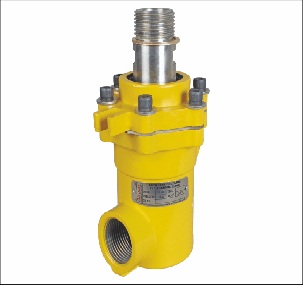Introduction of Rotary Joint

It is a rotary sealing device used to connect rotating equipment to fixed piping to transfer steam, water, and other fluids. It is also famous as a rotary union or Rotary Joint. Air, hydraulic oil, thermal oil, coolant, and other media. It is possible to design rotaries with multiple passages and manage multiple types of media at the same time. The O-ring seal prevents fluids from “crossing over” into another passage. Oil and gas, food and beverage, aerospace, robotics, and medical devices all use soft seal rotary unions. For transmitting electrical signals and hydraulic power, rotary unions may equip with slip rings.
A spring-loaded seal keeps fluids or gases from dispersing into the atmosphere in conventional rotary joints. Once the rotary joint is operating, its internal seating maintain by the spring, and it is pressure-seal. The low-pressure or vacuum services rely on spring force to create seals. A rotary joint is usually supports either internally by a carbon guide or externally by rods or a mounting bracket.
Rotary unions with balance seals are typically use with fluids (e.g. water, coolant) but can also use with steam and other gases. By adjusting the spring pressure within the rotary union, balance seal technology creates a positive seal. The sealing load is little affects by the operating pressure of the media. A balance seal is usually a flat-face seal and a rotary union supports by a ball bearing.
These moisture separators collect water droplets into a bowl or vessel. This bowl has to be empty from time to time. There are also drain valves that come into action to drain water droplets collected by a moisture separator.

Rotary joints and rotary unions are primarily made up of seals. Seals can experience internal loading forces as a result of fluid pressure and friction caused by face-to-face contact. Seal rings can also be affected by factors such as machine speed, temperature, and media users. A rotary union is largely as good as its seal package. Seals of poor quality wear out faster, resulting in more maintenance, downtime, and repair expenses. Media escapes when a seal fails, which reduces the efficiency of the entire heating or cooling process. Therefore, the actual replacement cost of a seal represents just a small portion of the total cost of a seal failure.
Also Read: Unknown Benefits of V Notch Ball Valve
Rotary Joint Maintenance Tips
After long-term use, rotary joint parts will wear, so it is necessary to often maintain them to extend their lifespan. I want to share with you today how to maintain a rotary joint:
- When the machine is inactive for a long period. The rotary joint will rust, resulting in equipment that is sticking or leaking when it is restarting.
- If the rotation axis is too concentric, the machine should stop immediately and replace it as soon as possible to prevent accidents.
- The rotary joint’s media outlet must be a hose, not a steel pipe. We recommend flexible metal bellows.
- Other accessories (such as valves and filters) should not place directly at the inlet and outlet of the rotary joint. Hoses can take in if necessary.
- Make sure the rotary joint swings by installing a fix support device.
- In a fix rotary joint, the outer and inner pipes rotate in opposite directions. When installing and designing, the inner pipe and the outer pipe should rotate in the correct direction.
- The rotary joints should be selected according to operating conditions (reference medium, size, pressure, temperature, speed, connection mode, rotation direction, inner tube, etc.).
- Consider the weight and siphon effect of the joint when choosing the length of the inner tube.
- Ensure the thread specifications and the length of the locking shaft head are correct when using threaded swivel joints.
- The long-time operation should avoid if there is no medium operation.




